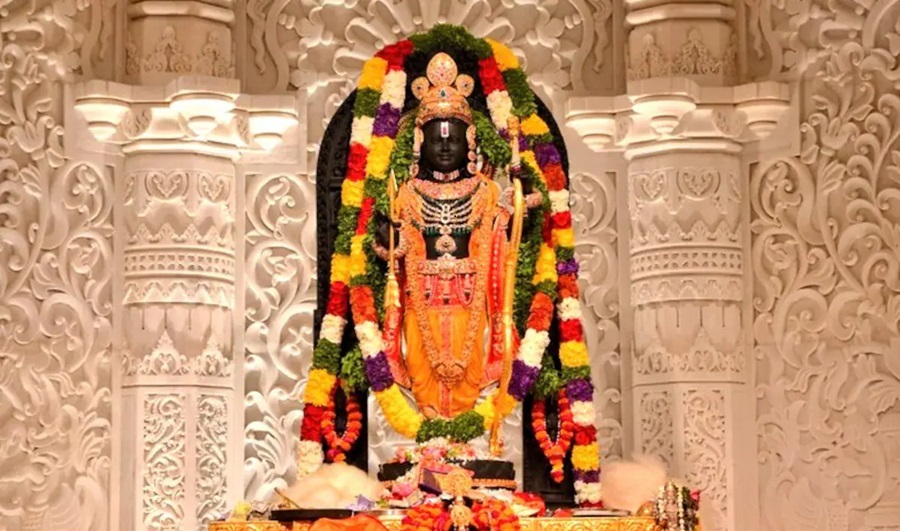Do you know the significance of Ram Lalla’s shringaar? Know key details and what happens to the old The grand opening of the Shri Ram Mandir in Ayodhya has captivated the hearts of devotees as they witness the divine appearance of Ram Lalla in all its glory. Beyond the 51-inch black stone idol depicting Lord Ram at the age of five, the ornaments worn by Ram Lalla hold profound significance. Let’s delve into the intricate details of Ram Lalla’s shringaar and the symbolic representation of each divine ornament.
Do you know the significance of Ram Lalla’s shringaar? Know key details and what happens to the old idol

Introduction
A. Grand opening of Shri Ram Mandir
The Shri Ram Mandir is now open to the general public, marking a historic moment after the grand pran pratishtha ceremony.
B. Unveiling the significance of Ram Lalla’s shringaar
While much has been said about the idol itself, the focus shifts to the captivating shringaar that adorns Ram Lalla.
Research and Conceptualization
A. Extensive research on Shri Ram’s appearance
Temple officials undertook extensive research, referring to texts such as Valmiki Ramayana and Ramcharitmanas to define Shri Ram’s appearance.
B. Ayodhya-based poet Yatindra Mishra’s role
Ayodhya-based poet Yatindra Mishra played a pivotal role in conceptualizing the majestic ornaments worn by Ram Lalla.
C. Craftsmanship by Lucknow-based Harsahaimal Shiamlal Jewellers
The intricate craftsmanship of these majestic ornaments was entrusted to Lucknow-based Harsahaimal Shiamlal Jewellers.
Garments and Accessories
A. Description of Ram Lalla’s attire
Draped in a golden yellow Banarasi fabric dhoti, adorned with a red angavastram featuring Vaishnav symbols, Ram Lalla’s attire is a visual delight.
B. Designer Manish Tripathi’s contribution
Delhi-based designer Manish Tripathi played a crucial role in crafting Ram Lalla’s garments, working diligently from Ayodhya Dham.
C. Symbolism of the divine crown (Mukut) and its intricate details
The divine crown (Mukut), forged from gold and adorned with rubies, emeralds, and diamonds, symbolizes opulence and devotion.
D. Kantha necklace and its sacred significance
Ram Lalla’s neck is adorned with the sacred Kantha, a crescent-shaped necklace featuring floral designs and symbols of good fortune.
E. Kaustubha Mani – A sacred tradition worn by Lord Vishnu
The Kaustubha Mani, a sacred tradition worn by Lord Vishnu, rests at the very heart of Ram Lalla, symbolizing divine connection.
F. Vaijayanti or Vijayamala – A symbol of victory
The Vaijayanti necklace, Ram Lalla’s third and longest necklace, is a golden manifestation intermittently studded with rubies, symbolizing victory.
G. Kanchi or Kardhani – Gem-studded waistband of gold
Adorning Ram Lalla’s waist is the Kanchi or Kardhani, a gem-studded waistband of gold, symbolizing purity.
H. Bhujbandh, Kangan, and Mudrika – Divine armlets, bangles, and rings
Bhujbandh on both arms, Kangan, and Mudrika on Ram Lalla’s hands signify divine strength and grace.
I. Chhada or Painjaniya – Anklets and toe rings
In humble reverence, the Chhada adorns Ram Lalla’s feet with gem-studded anklets and toe rings, resonating with every sacred step.
J. Golden bow and arrow in Ram Lalla’s hands
A golden bow adorned with pearls and a golden arrow symbolize divine protection and the triumph of righteousness.
K. Traditional tilak on Ram Lalla’s noble forehead
Ram Lalla’s noble forehead is adorned with a traditional auspicious tilak, created with diamonds and rubies.
L. Silver toys as part of the shringaar
As Ram Lalla is in the form of a five-year-old child, traditional silver toys, including a rattle, elephant, horse, camel, toy cart, and a spinning top, embody innocence and joy.
Divine Ornaments and Idols
A. Garland of vibrant floral patterns
Ram Lalla’s noble forehead is adorned with a garland of vibrant floral patterns, meticulously crafted by dedicated hands.
B. Resplendent golden umbrella above Ram Lalla’s radiant halo
Above Ram Lalla’s radiant halo, a resplendent golden umbrella unfurls, casting a celestial shade upon the divine presence.
C. Placement of the old idol in the Ram Mandir
While the focus shifts to the new idol, the old idol remains in the Ram Mandir, preserving the sacred connection with the past.
Conclusion
A. Recap of the grandeur of Ram Lalla’s shringaar
The shringaar of Ram Lalla is a testament to divine craftsmanship and symbolic representation, adding to the sanctity of the Shri Ram Mandir.
B. Importance of preserving the old idol in the Ram Mandir
While the new idol takes center stage, preserving the old idol in the Ram Mandir ensures continuity and reverence for the divine heritage.
FAQs
A. Why is the Mukut adorned with Vaishnav symbols?
The Mukut symbolizes opulence and devotion, with Vaishnav symbols like Padma, Shankh, Mayur, and Chakra, adding divine significance.
B. Who conceptualized the ornaments worn by Ram Lalla?
Ayodhya-based poet Yatindra Mishra played a crucial role in conceptualizing the majestic ornaments worn by Ram Lalla.
C. What is the significance of the Kantha necklace?
The Kantha necklace, adorned with floral designs and symbols of good fortune, holds sacred significance in Ram Lalla’s shringaar.
D. Why are traditional silver toys part of Ram Lalla’s shringaar?
As Ram Lalla is in the form of a five-year-old child, traditional silver toys embody innocence and joy, enhancing the divine aura.
E. How does the Vaijayanti necklace symbolize victory?
The Vaijayanti necklace, adorned with auspicious symbols, symbolizes victory in the Vaishnava tradition, adding divine grace to Ram Lalla’s appearance.
ALSO READ-Unveiling the Grandeur: Ram Mandir Pran Pratishtha Ceremony